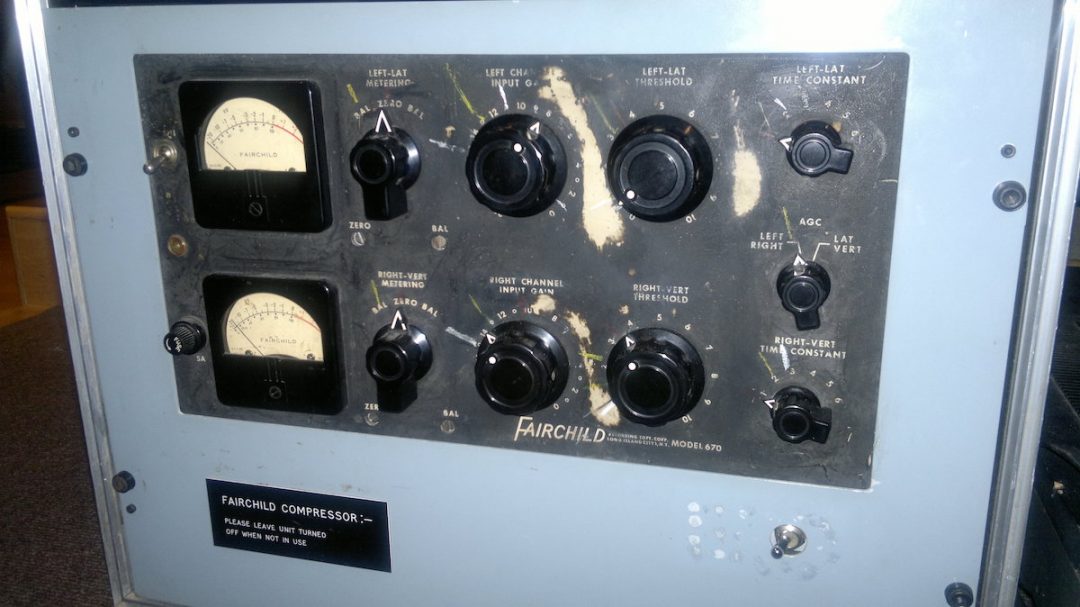Every professional mix/master you’ve heard has benefitted from a splash of bus compression. It adds what we call “glue” to a mix by smoothing out the overall dynamic range of the material.
Done well, mix bus compression can take your track to a completely different level! But done haphazardly, it can flatten out a mix and make it totally lifeless.
What is Mix Bus Compression?
Bus compression refers to a stereo compressor placed on the mix bus (also called the “master” or “stereo” bus) which acts on the entire stereo mix. This technique originated in the late ’70s when artists started noticing a difference in sound between what they heard in the studio versus the radio and their home record players.
The radio broadcast and vinyl record sounded different because they went through another round or two of compression during broadcast and mastering. To compensate, engineers in the studio started adding gentle compression across the mix bus.
Naturally everybody loved the sound, so it’s now common practice to add a few dB of compression on a mix every single time.
Which bus compressor is up to the task?
The compressor you use is going to impart its color on your mix—there’s no way around it. Engineers consistently rely on a few favorites, like the Fairchild 670, Neve 33609, or SSL bus compressor. They all have a desirable tone that works great on whole mixes. The Fairchild, for instance, is a beast of a tube compressor. You can probably think of a bunch of adjectives describing what tubes sound like, right?
You certainly don’t need the expensive hardware to get great results in your DAW. Your go-to plugin emulation of any of the top mix bus compressors is a fantastic substitute for legendary analogue gear. Sometimes engineers will open up a bus compressor with no threshold, just to hear how it colors a mix without actually compressing anything. This is a perfect way to get to know the character of your compressor to help you pick which one you like best!
Of course, don’t be shy about trying any one of your favorite compressors on the mix bus—even stock DAW ones. You won’t know how it sounds until you’ve loaded it up!
Bus Compressor Settings
Your bus compression should be pretty gentle. If it’s too aggressive, your mix can noticeably and unpleasantly “pump,” sound distorted, or sound lifeless and dull. Usually a dB or two of gain reduction is all it takes for a noticeably different sound.
When going for “glue” that holds all the instruments together, you’ll want to start off gently:
- Attack: Slow. A slow attack time lets the transients in the material through. If it’s too fast, you’ll flatten everything out—it won’t sound good at all. Somewhere around 100 ms is a good place to start. Some classic compressors like the SSL have fixed attacks, so you can choose whichever the slowest is!
- Release: Medium-fast or tempo-synced. You don’t want the compressor to always be on for the mix bus. If the release is too fast, it will audibly pump. Too slow, and it’s squashing the dynamic range. Start somewhere around 5 ms and adjust to taste. A good rule to keep in mind is that the meter should be returning to 0 dB between kick/snare hits.
- Ratio: Between 2:1 and 4:1. Again, subtlety is key here. If you’re ratio is too high, you’re making the compressor work too hard for the mix. Start with 2:1 and see how it sounds. For what it’s worth, a time-honored starting ratio on the SSL is 4:1, but ultimately that’s for you to decide!
- Threshold: To taste. Your threshold should be high enough that you’re only getting 1-2 dB of gain reduction.
There’re also two approaches for adding mix bus compression.
- At the beginning of the mix
- At the end of the mix
#2 seems like the logical choice since you’re finishing things up and adding some universal processing to the whole mix. Ultimately, there are different reasons why you might use either technique.
At the beginning of the mix
This means you’ll add a compressor to your master bus right at the start of a mix and shape your mix into it.
The first advantage is that the mix will come together a little quicker because you’ve added “glue” from the jump. Secondly, you might use slightly less compression on individual tracks because you’ve already got it going on the mix bus. Finally, the bus compressor is going to even out instruments a lot, so you may not need to automate fader levels as much.
If you start a mix with bus compression, you’ll find you’re doing quite a bit more gain reduction than if used at the end. This is normal!
At the end of the mix
Bus compression at the end of a mix is probably the most common approach. Your settings should be less aggressive, as we outlined above, because you already used ample compression on individual tracks. A dab of gain reduction is all you’ll need.
The biggest advantage to adding bus compression at the end is if you don’t like it, you can easily turn it off or swap it out for a different compressor. You aren’t married to any sound like you are when you mix into a bus compressor.
